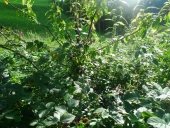
 6
6




 )
)
 3
3




"Despite all our accomplishments we owe our existence to a six-inch layer of topsoil and the fact that it rains."
 5
5




J Youngman wrote:You might want to use Crossvine as an alternative to Trumpet Creeper. Trumpet Creeper will spread like crazy and end up anywhere you don't want it. Crossvine is much less aggressive.
 1
1




 2
2




Travis Davis wrote:Hello all,
So A little background information:
I recently started my first vegetable garden this year and I caught the itch, meaning I want to grow anything and everything I can get my hands on. Haha I was blessed to be in a position where we have a family farm that is a little over 17 acres and my family had already planted a few apple and pear orchards on the property. I’ve been doing my digging in the garden but also I’ve been doing extensive research on this site as well as other places on the interweb and came up with the conclusion that I want to leave my mark on the property in the form of a peach&apricot tree polyculture/fruit guild/food forest.
As of now the two major areas of concern are site placement, which I feel that I have figured out a good enough spot for all three trees with around 12-15 feet in between each tree in the same guild, and pest pressure. To deal with the pest pressure I have come up with a combination for plantings for year one and I’d like some input to see what has and hasn’t worked for others in the past. Our property is located in zone 6B.
Focal point:
Redhaven peach
George IV peach
Moorpark apricot
(Varieties were purchased from treesofantiquity.com)
Canopy:
Black walnut (we have a shortage here on the farm and we have some saplings already volunteering in the area. I have read about juglone and it’s ability to hinder/deter growth in and around the root system, however I read that mulberries planted between walnut trees and fruit trees severely lessens the affect of juglone on the overall system. I’d love to hear input before I go planting my peaches and apricot that I spent money on just to try and save a volunteer variety)
Red bud (similar reasoning, they are volunteering and I need some nitrogen fixing trees that can be made into mulch in the future, as well as aesthetically pleasing)
Sub-canopy:
Mullberry (will need at least a male and female if I want fruit, hoping some wild grapes will volunteer close)
Pawpaw (the thought process here is that in the early part of their life they enjoy shade and the peach trees are short lived so after the peach tree dies back/becomes unproductive in 10-15 years the pawpaw will be there to thrive {thank you @edibleacres YouTube channel!})
Shrub:
Lavender (every lavender shrub I’ve ever seen was covered in pollinators, likes variable soil, low maintenance, natural insecticide to aid in prevention of plum curculio/coddling moth, lovely smell, aesthetically pleasing, medicinal)
Herbaceous:
Comfrey (living mulch, mineral accumulator, rhizome barrier)
Hastas (living mulch, home for praying mantis)
Tansy (I’ve read somewhere that this is beneficial to peaches, blackberries and raspberries because they bring in predator wasps, any confirmation/correction would be appreciated
Borage (beneficial predators)
Mint (aromatic confuser, medicinal, herb)
Milkweed (monarch butterfly, pollinator heaven, I kinda think they look pretty)
Ground cover:
Clover (nitrogen)
Buckwheat (Phosphorous)
Root:
Carrot (I’ve read that the carrot family brings in beneficial predators, aerates soil)
Garlic (aromatic confuser, edible, aerates soil)
Tulips (aesthetically pleasing, perennial)
Vine:
Trumpet creeper (hummingbird food, potential windbreak, aesthetically pleasing)
I’ve seen a lot of people warn of planting too dense in a location. The way I see it is if something isn’t working, it will get out-competed by what does. Plant the things that need the most time to develop first and work toward the annuals.
Thanks in advance for any advice, tips, tricks, and any overall knowledge that could be provided. I’ve already learned an immense amount from this sit and hope to continue by posting for often.
Bless you.




"Despite all our accomplishments we owe our existence to a six-inch layer of topsoil and the fact that it rains."




J Youngman wrote:Flame Acanthus (it grows as a bush) is the best hummingbird plant I have found, they go crazy for it. Salvia is also pretty good.
 2
2




 ) and have been collecting seeds over the past few months. I’m excited for this winter to get stratifying some seeds and hopefully collect some other hardwood cuttings as well to add to the landscape.
) and have been collecting seeds over the past few months. I’m excited for this winter to get stratifying some seeds and hopefully collect some other hardwood cuttings as well to add to the landscape.  1
1




"Despite all our accomplishments we owe our existence to a six-inch layer of topsoil and the fact that it rains."




J Youngman wrote:Didn't know they offered seedlings. Those are great prices. Would love updates on shipping/product quality and survival rate.




 1
1








Glen Kowalski wrote:I would consider blue lupine as well. Nitrogen fixer either biennial or short-lived perennial, attractive to both pollinators and the eye and deer resistant. Also cycles P fairly well. Oats to help establish mychorizal fungi would also be helpful.
 2
2




J Youngman wrote:Didn't know they offered seedlings. Those are great prices. Would love updates on shipping/product quality and survival rate.
Whatever it takes to dodge a time clock.

 2
2




Hans Albert Quistorff, LMT projects on permies Hans Massage Qberry Farm magnet therapy gmail hquistorff

|
Any sufficiently advanced technology will be used as a cat toy. And this tiny ad contains a very small cat:
The new gardening playing cards kickstarter is now live!
https://www.kickstarter.com/projects/paulwheaton/garden-cards
|







